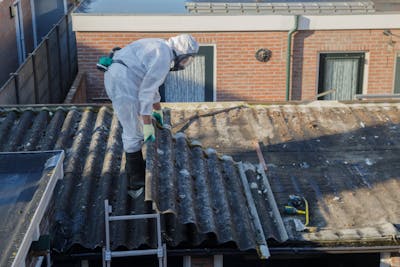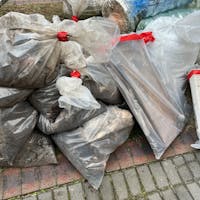Find the Best Asbestos Removalists Near You
- Post a job
- Receive multiple quotes
- Choose your preferred Asbestos Removalist
Where do you need Asbestos Removal?
Describe your job and our suppliers will send you quotes
240 Asbestos Removalists on iseekplant
When it comes to hazardous materials, asbestos needs careful handling, especially before any demolition work. With 240 reputable asbestos removalists on the iseekplant network, you can find a qualified professional ready to safely and efficiently handle your asbestos concerns.
This quick guide highlights all you need to know about asbestos removal. We look at rates, a breakdown of these rates, the differences between Class B and A asbestos removal, what equipment or related service you'll need for asbestos removal and the dangers of asbestos.
Asbestos Removal Rates Guide
Asbestos removal is essential for ensuring inhabitants' safety and health in structures built before its ban in the 2000s. Given the hazardous nature of asbestos and the specialist skills required for its safe removal, hiring a professional is necessary. Here's a guide to help you understand the average costs involved:
Average Asbestos Removal Rates per Property Type
| Size/Type of Property | Dry Hire Rate | Wet Hire Rate |
|---|---|---|
| Small Residential | $1,000 - $3,000 | $2,500 - $4,500 |
| Large Residential | $4,000 - $8,000 | $6,000 - $12,000 |
| Commercial/Industrial | $10,000 - $50,000 | $15,000 - $65,000 |
Average Asbestos Removal Rates per Area
| Area of the House | Average Cost (per sq. metre) |
|---|---|
| Roof | $30 - $50 |
| Interior Walls | $25 - $40 |
| Exterior Walls | $20 - $35 |
| Floor Tiles | $25 - $45 |
| Ceiling | $30 - $50 |
Note: All prices listed in this section are estimates, exclude GST and are in AUD. Price estimates can vary based on location and additional requirements.
Additional Costs to Consider When Hiring Asbestos Removalists
Engaging in asbestos removal is about more than just the direct costs of the removal process. These additional costs can add to your project's overall budget:
| Additional Cost | Description | Estimated Cost |
|---|---|---|
| Asbestos Inspection and Report | Costs involved in professionally inspecting the property and drafting a detailed asbestos report | $250 - $750 |
| Asbestos Disposal Fees | Fees for safely disposing of removed asbestos in designated facilities | $50 - $100 per ton |
| Replacement Materials | Costs for replacing materials after asbestos removal, such as insulation or wallboards | Varies based on choice |
| Protective Equipment | Costs for essential protective gear such as masks, gloves, and suits needed during removal | $50 - $150 per set |
| Labour Overtime (if needed) | Additional hourly rates when the crew works beyond regular hours | $50 - $100 per hour |
| Site Preparation | Costs to ensure the site is ready and safe for asbestos removal, including setting up containment zones | $100 - $300 |
| Emergency Call-out Fees | Additional costs when the removalist service is called in for urgent or unscheduled removal tasks | $150 - $300 |
| Travel and Transport Fees | Expenses associated with travelling to the site and transporting equipment and removed materials | $50 - $150 |
Remember, these are estimates, and actual costs can vary based on location, project specifics, professional experience and reputation. Use our Get a Quote tool to ask for detailed quotes from multiple removalists on our network to get a clear picture of potential expenses today!
Asbestos Removal Rate Breakdown
Asbestos removal is a delicate process that covers various tasks, each contributing to the overall cost. To aid you in understanding these expenses, we've detailed a breakdown of the most common cost components. This way, you can budget effectively and recognise the value of hiring professional asbestos removalists to ensure safety and compliance.
- Labour Costs: Typically, the primary expense. The team's expertise ensures the safe removal and disposal of asbestos.
- Disposal Fees: Disposing of asbestos requires adherence to strict environmental regulations, which often come with associated costs.
- Transportation: Depending on the job's location, transporting the asbestos to approved disposal sites can add to the overall cost.
- Protective Gear: Safety first! The right equipment is a non-negotiable in this line of work, and its cost reflects its importance.
Class A vs. Class B Asbestos Removal
Knowing the differences between Class A and Class B asbestos removal is crucial, as each classification deals with different types and risks of asbestos. To help you decide and ensure compliance with safety standards, it's essential to understand the specifics of each class. Below, we examine the primary differences and implications of both types:
- Class A Asbestos: This involves friable asbestos, which is crumbly and can easily release fibres into the air. Removalists handling Class A must have specialised training.
- Class B Asbestos: Involves non-friable asbestos, such as in asbestos cement sheets. It's more bound together and less likely to release fibres.
What Are the Dangers of Asbestos?
Asbestos was a popular building material, popular for its heat resistance and insulation properties. However, prolonged exposure poses severe health risks:
- Asbestosis: A lung disease caused by inhaling asbestos fibres.
- Lung Cancer: Especially in those who have prolonged or combined exposure to smoking.
- Mesothelioma: A rare cancer affecting the lining of the lungs, chest cavity or abdomen.
Being aware of the risks emphasises the need for professional removalists. Always opt for specialists when dealing with such hazardous materials.
Essential Equipment and Services for Asbestos Removal
Successfully and safely removing asbestos requires a combination of specialised equipment and services. Each tool and service plays a pivotal role in the process, from containing and extracting asbestos fibres to ensuring the proper disposal of contaminated waste.
Using the right equipment ensures asbestos removalists protect the environment and their specialists from potential hazards. A comprehensive approach ensures the utmost safety and efficiency throughout the removal process.
These tools and services are critical in asbestos removal:
- Asbestos Disposal Bags: These specialised bags are used to safely contain and transport asbestos waste, ensuring no particles are released into the environment.
- Air Filtration Machines: Essential for maintaining clean air within the removal site, these machines filter out hazardous asbestos fibres.
- Safety Suits and Respirators: Personal protective equipment is crucial. These suits and masks prevent asbestos inhalation and skin contact.
- Negative Air Pressure Units: These machines help maintain a contained environment, ensuring that asbestos fibres don't spread to surrounding areas.
- Hydraulic Hammer Hire: Hydraulic hammers can be used to demolish structures with asbestos, minimising fibre release safely.
- Concrete Cutting: Often, asbestos is found within concrete structures or floors. Concrete cutting services are essential for accessing and safely removing the embedded asbestos.
- Crusher Dust: After asbestos removal, crusher dust can be used to stabilise a site, especially if the asbestos is within or under structures.
- Dump Truck Hire: Dump trucks are necessary for transporting large quantities of contaminated waste to designated disposal sites, ensuring the hazardous material is appropriately handled.
Understanding the various equipment and services crucial to asbestos removal can ensure a safer and more efficient process. Each tool or service plays a specific role in preventing asbestos's spread and potential health risks.
Ready to Take the Next Step?
Choosing the right asbestos removalist is vital not just for property safety but also for health. Explore our vast list of professionals, compare and find the perfect match for your project. Ensure safety and compliance with iseekplant today.
Got questions? Feel free to reach out at projects@iseekplant.com.au or dial 1300 691 912. If you're prepped to make a move, hit 'Get a Quote' right away!
Popular Asbestos Removal Locations
Related Categories
Become a supplier
Recent Asbestos Removal reviews
"Professional beyond expectation & requirements. Diligent to effort as they are detailed to task at hand."
- GaryView profileHow It Works
Asbestos Removal FAQs
Here are some frequently asked questions and tips on finding the right asbestos removalist for your job.
What do we have to offer?
Want to Know More?

2022 Asbestos Removal Cost Guide- Find services | iseekplant
Asbestos refers to a group of six fibrous minerals which are naturally o...



